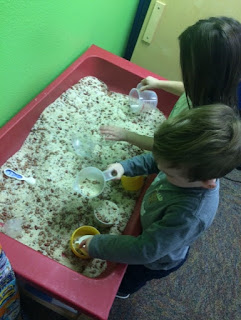The first week of school each year, I spend a lot of time practicing routines with my students. I make it a goal of mine to make every child in my class feel loved and safe so those first few weeks are so important in setting the atmosphere. I introduce one or two centers a day until all of the centers are open and running smoothly. I take pictures of areas around our classroom and make routine books that we read and reread throughout the first couple of weeks. I create Science, Technology, Engineering, Arts, Math boxes that I place at our Science Center, along with magnifying lenses and a scale. The STEAM boxes match whatever theme we are covering.
I separate our blocks by color and store them in matching colored boxes so that children are easily able to replace the blocks when they are done playing. These are stored in our Block Center.
I label our toy cubbies with pictures so that children know where each toy is stored and they are easily able to find them and put them away.
Each child has a quiet box under their cubby for quiet time. I rotate the quiet boxes weekly so that they have the opportunity to try each activity. The quiet boxes are mostly fine motor activities that students can work on independently and quietly.
The first half of the year, I lay out each child's name card on a table and they find their name as the enter the room. This is how I take attendance and it gives children practice recognizing their name. For the second half of the year, I lay out an attendance sheet and each child writes their name on the sheet.
For birthdays, I allow the birthday child to create a birthday cake using felt pieces with the corresponding number of candles and then we show the class the cake and sing Happy Birthday to them.
Our Dramatic Play Center has dress up clothes and a kitchen set. I add materials throughout the year to supplement our themes.
Our Literacy Center has writing utensils, paper, a journal for each child, word cards, sand boxes and a journal idea list.
Our Fine Motor/Sensory Center has our sensory table and other materials that I rotate through such as writing boxes with sand or playdough, mini erasers, stickers or water.
When the students enter the classroom, I meet them at the door and offer them a high five, a hug, a handshake, a fist bump or a wave depending on their preference for the day. At dismissal time, we gather on the rug and sing our good-bye song before heading home. It is really important that the students feel part of the community in my classroom.
I separate our blocks by color and store them in matching colored boxes so that children are easily able to replace the blocks when they are done playing. These are stored in our Block Center.
I label our toy cubbies with pictures so that children know where each toy is stored and they are easily able to find them and put them away.
Each child has a quiet box under their cubby for quiet time. I rotate the quiet boxes weekly so that they have the opportunity to try each activity. The quiet boxes are mostly fine motor activities that students can work on independently and quietly.
The first half of the year, I lay out each child's name card on a table and they find their name as the enter the room. This is how I take attendance and it gives children practice recognizing their name. For the second half of the year, I lay out an attendance sheet and each child writes their name on the sheet.
For birthdays, I allow the birthday child to create a birthday cake using felt pieces with the corresponding number of candles and then we show the class the cake and sing Happy Birthday to them.
Our Dramatic Play Center has dress up clothes and a kitchen set. I add materials throughout the year to supplement our themes.
Our Literacy Center has writing utensils, paper, a journal for each child, word cards, sand boxes and a journal idea list.
Our Fine Motor/Sensory Center has our sensory table and other materials that I rotate through such as writing boxes with sand or playdough, mini erasers, stickers or water.
When the students enter the classroom, I meet them at the door and offer them a high five, a hug, a handshake, a fist bump or a wave depending on their preference for the day. At dismissal time, we gather on the rug and sing our good-bye song before heading home. It is really important that the students feel part of the community in my classroom.








Comments
Post a Comment